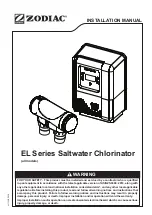
Page 7
Page 6
EL Series Saltwater Chlorinator | Installation Manual
Section 3. Plumbing
The cell must be plumbed in a position that is
accessible for maintenance and within 1.5 meters
of the controller. The cell should be the last piece
of equipment in the circulation system. The cell
must be installed horizontally, level and with
correct fl ow orientation, see Figure 3.
1. If you intend to plumb the cell on a bypass,
the bypass must be equipped with Isolation
valves, see Figure 3.
2. Plumb the cell inlet and outlet on vertical
lengths of 50 mm PVC pipe (if using 40mm
pipe, use the provided 40mm reducers). The
cell inlet and outlet ports are 11.5 cm apart,
see Figure 2. The inlet of the cell is on the side
closest to the electrical lead, see Figure 4.
3. Put the unions onto the inlet and outlet pipes,
see Figure 4.
4. Glue the adapters directly onto the pipes.
5. Ensure the o-rings are seated properly on the
adapters.
6. Secure the cell to the plumbing by
tightening the unions hand tight. DO NOT
OVERTIGHTEN.
7. Double check cell orientation. The cell inlet is
closest to the cell electrical lead.
Figure 3. Plumbing Cell Only
Cell
Adapters
Unions
Adapter O-ring
Reducer
Figure 4. Cell Plumbing Assembly
WARNING
• The cell must be installed horizontally and level.
Improper installation can lead to gas build up which
could result in equipment damage or serious injury.
• The cell must be the last piece of equipment on
the return line, see Figure 3.
• It is recommended in all installations that the cell is
installed on a bypass equipped with isolation valves,
see Figure 3.
• In order to avoid load loss, installing the cell on a
bypass is MANDATORY if system flow rated exceeds
300 Lpm, see Figure 3.
• If installing on a bypass, use a downstream check
valve instead of a manual valve to prevent improper
back flow into the cell.


































